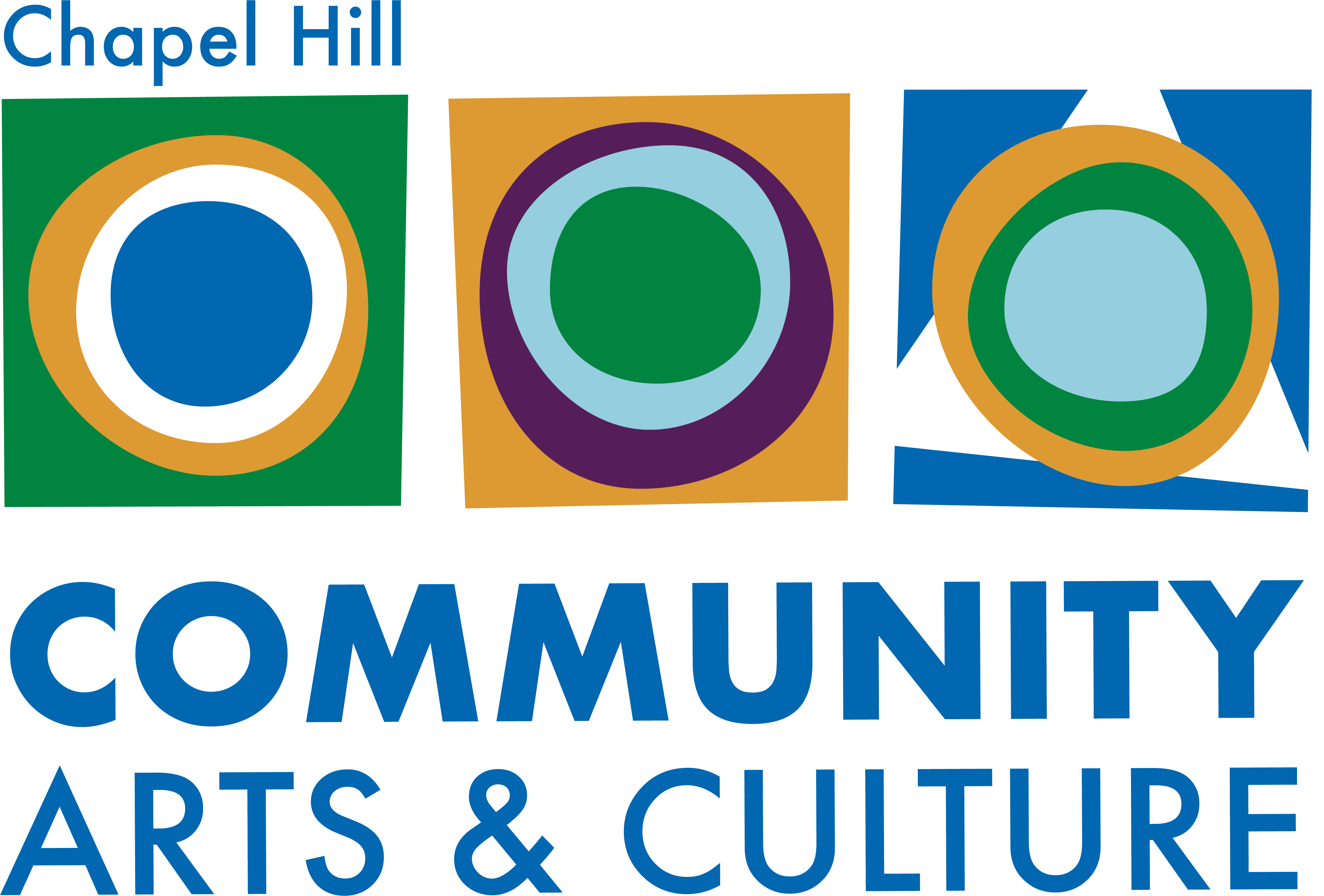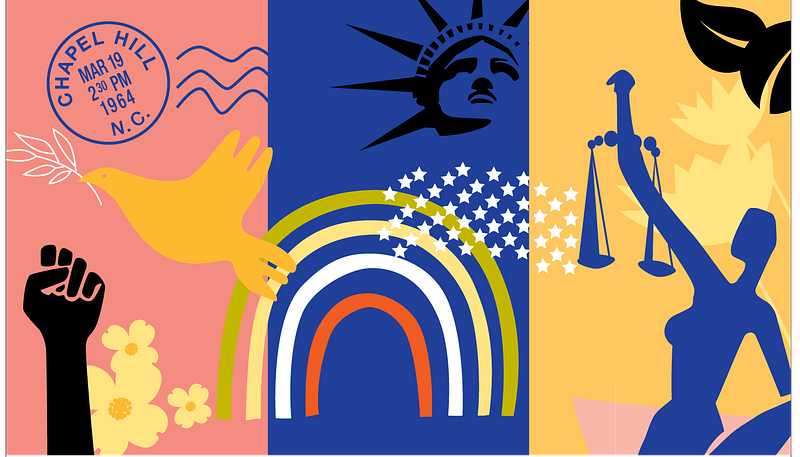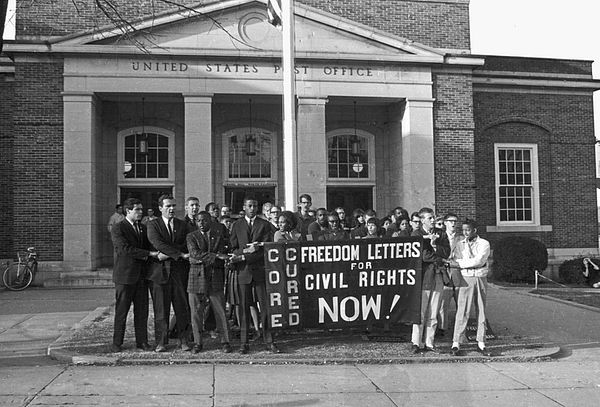Via Chapel Hill Community Arts & Culture, Article by Melissa Bartoletta
Peace & Justice Plaza, located in downtown Chapel Hill, is now energized with mural art banners that reflect the ideals of those honored at the plaza. The inaugural banners, created by Triangle artist Victoria Primicias, will hang between the columns of the Post Office building for several months. Chapel Hill Community Arts & Culture coordinated the project and encourages the community to come downtown to see the art and learn more about the people honored at the plaza.
“A FANTASTIC WAY TO ENGAGE WITH THE BLACK LIVES MATTER MOVEMENT”
The project was envisioned in the weeks following the death of George Floyd as a way to engage the community and raise awareness of the struggles for racial and social justice that continue in our community and our country. Emile Charles, Chapel Hill resident and UNC student, approached Community Arts & Culture about the possibility of public art at Peace & Justice Plaza. “I thought a community art piece was a fantastic way to engage with the cultural side of the BLM movement,” says Charles. After considering what was possible at a historic building and during a pandemic, staff landed on the idea of mural art banners. After the project launched, Mr. Charles served on the committee that chose the artist and design for the first banners.
“PARTICIPANTS ONLY DRANK WATER AND SMOKED CIGARETTES”
Peace & Justice Plaza was dedicated in 2006 by Chapel Hill Town Council, as a way to honor individuals, no longer living, who dedicated their lives to peace and justice in Chapel Hill. There are currently seventeen names inscribed on the plaza, including Charlotte Adams, founder of the local branch of the Women’s International League for Peace and Freedom in 1935, Hank Anderson, the first black Parks and Recreation Director in North Carolina in 1969, and Rebecca Clark, the first Licensed Practical Nurse to work in the UNC campus infirmary in 1953.
In addition to the people honored there, the Plaza itself has been the spot of many historic protests for peace and justice. In March of 1964, four members of the Freedom Movement staged a fast on the lawn of the Old Post Office, now the plaza, to try to force local officials to reconsider the decision against the accommodations ordinance that would have ended segregated business practices. Known as the Holy Week Fast, participants “only drank water and smoked cigarettes” for the eight days leading up to Easter of that year. Beginning on January 4, 1967, Charlotte Adams and other members of the local chapter of the Women’s International League for Peace and Freedom led a weekly peace vigil protesting the Vietnam War in front of the Franklin Street Post Office. Those weekly vigils continued every Wednesday until 1973.
“A WELCOMING SPACE FOR THOSE WHO ENTER THE PLAZA”
Designed by Triangle artist Victoria Primicias and reminiscent of a post card, the mural banners, “New Voices”, are a bright, graphic montage of local elements and widely recognized symbols that represent the struggle for social justice. A raised fist represents Black Lives Matter and the fight for racial justice, while a rainbow shows solidarity with the LGBTQ+ community and a dove with an olive branch is a universal symbol of peace. “The intent of my design is to provide a welcoming space for those who enter the Plaza and to lift their spirits while enjoying the space.” says Primicias on the art. The banners are also postmarked with the date March 19, 1964. That date reflects the date on a leaflet distributed to passersby during the 1964 Holy Week fast.
Knowing that Peace & Justice Plaza has played such an integral role in the local struggle for civil rights, the site became the first pick for new art on the theme of racial and social justice. Emile Charles hopes the community will visit and reflect on the arts. “Not only are folks now seeing ‘New Voices’ as they drive through our town’s main street and downtown hub, but the piece also represents some of the things our community holds dearly: protest, equity, the fight for civil rights, and the peace that we hope comes following. It was such a pleasure to see the Community Arts & Culture team run with this idea and make my abstract June concept a reality,” says Charles.
LEARN MORE ABOTUT THE PLAZA WITH POEM, PODCAST
You’re invited to celebrate the art and the people who have vastly contributed to our community. Follow along with Community Arts & Culture’s social media to learn more about the art, Peace & Justice Plaza, and the people honored at this spot. A newly commissioned poem on peace and justice by Chapel Hill Poet Laureate, CJ Suitt will also be released this April. Learn more about the plaza and the people honored there by listening to Chapel Hill’s very own history podcast, Re/Collecting Chapel Hill and exploring the website at chapelhilhistory.org. For more information on Community Arts & Culture, visit chapelhillarts.org.
Steve Wright public art coordinator for Chapel Hill Community Arts & Culture, and Emile Charles joined Aaron Keck for a conversation about the origins of the Peace & Justice Plaza public art. You can listen to to the full interview here.
 Chapelboro.com has partnered with the Chapel Hill Community Arts & Culture to bring arts-focused content to our readers. Community Arts & Culture is a division of the Town of Chapel Hill with a mission to inspire creativity and celebrate community for a better Chapel Hill. Experience the arts and see what’s happening at chapelhillarts.org
Chapelboro.com has partnered with the Chapel Hill Community Arts & Culture to bring arts-focused content to our readers. Community Arts & Culture is a division of the Town of Chapel Hill with a mission to inspire creativity and celebrate community for a better Chapel Hill. Experience the arts and see what’s happening at chapelhillarts.org




